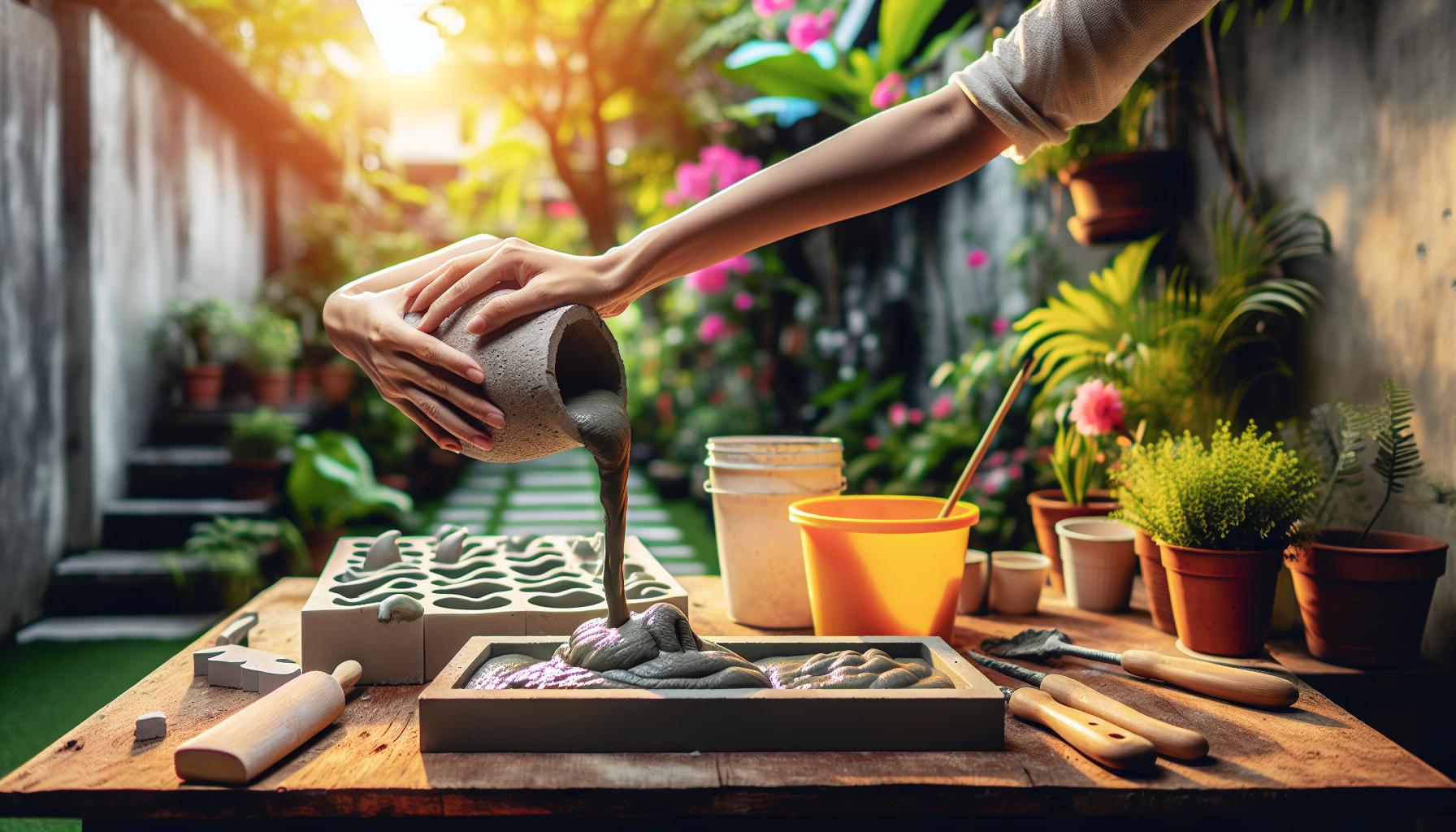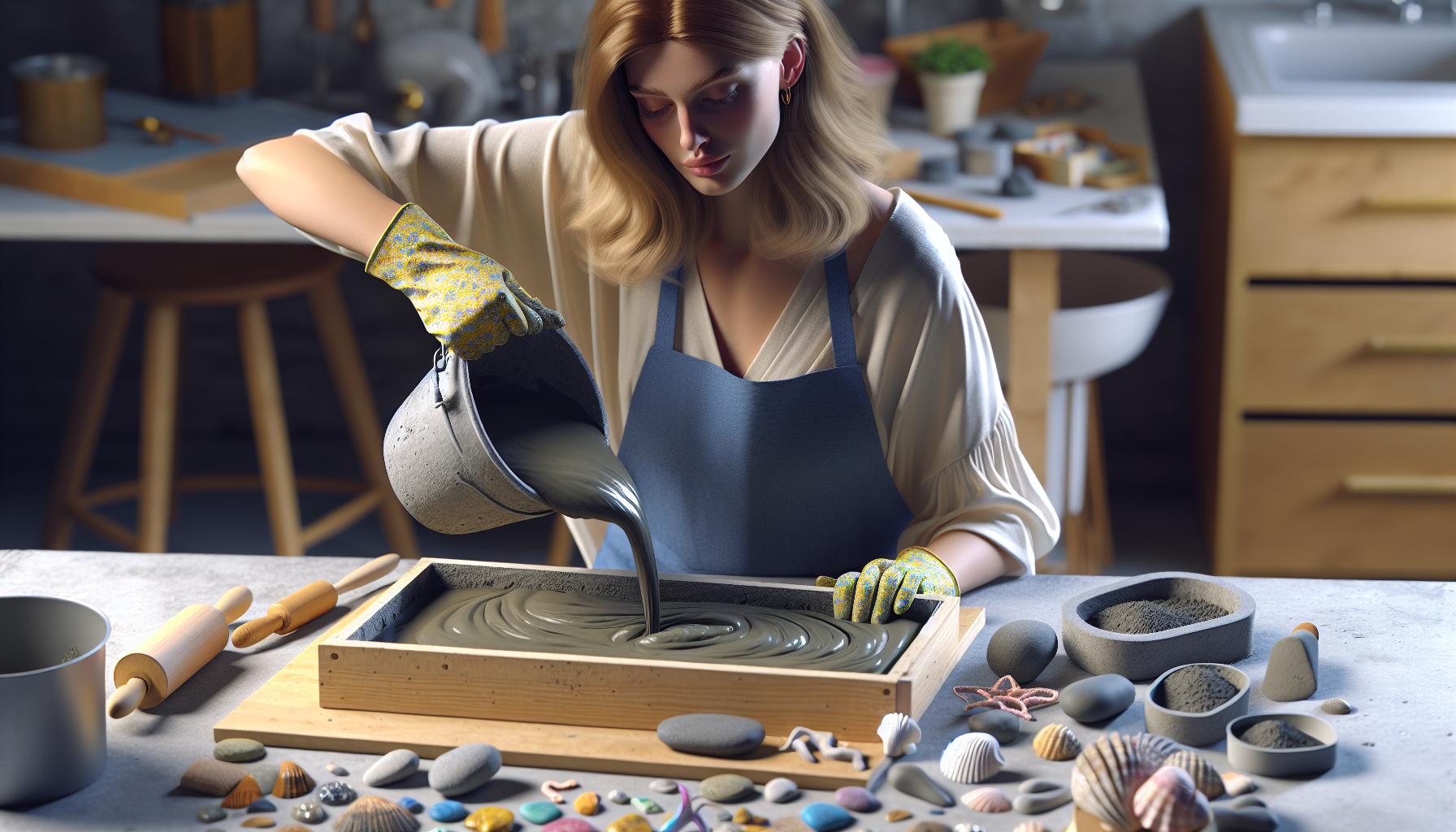I’ve always found something incredibly satisfying about creating something tangible with my own two hands, and concrete DIY projects offer the perfect blend of creativity and durability. Whether you’re a seasoned DIY enthusiast or just starting out, concrete’s versatility can transform ordinary ideas into extraordinary creations. From chic planters to custom countertops, the possibilities are endless.
Concrete might seem intimidating at first, but with the right guidance and a bit of patience, it becomes a surprisingly accessible material. It allows you to bring a touch of modern elegance or rustic charm to your home and garden without breaking the bank. Plus, the sense of accomplishment you’ll feel after completing a project is unmatched.
In this article, I’ll delve into the world of concrete DIY projects, sharing tips and inspiration to help you get started. Let’s explore how you can turn this humble material into stunning, functional pieces.
- Concrete DIY projects combine creativity and durability, transforming simple ideas into practical and stylish pieces for home decor and the garden.
- Getting started with concrete is accessible with proper guidance, helping beginners to confidently tackle various projects from coasters to planters.
- Choosing the right materials and tools, including the type of concrete mix and essential equipment like molds and protective gear, enhances the project’s success.
- Simple projects suit beginners, while intermediate and advanced designs like stepping stones, candle holders, furniture, and countertops challenge more experienced DIY enthusiasts.
- Ensuring safety, including wearing gloves and masks, and following preparation and curing best practices, are crucial for successful concrete projects.
Concrete DIY Projects
Concrete DIY projects offer an extraordinary blend of creativity and practicality. Concrete, a versatile and durable material, allows you to transform spaces with customized designs, from garden planters to stylish countertops. Working with concrete involves mixing aggregates like sand, gravel, and cement with water to form a moldable paste that hardens over time.
Common tools for concrete tasks include molds, mixers, and trowels. Molds, for instance, help shape the concrete into desired forms; mixers ensure a consistent blend, and trowels facilitate smoothing the surface. Safety gear such as gloves and masks protects against dust and chemicals.
Choosing the right type of concrete ensures project success. For intricate designs, mix ratios and additives like colorants can adjust texture and appearance. Rapid-setting concrete suits tasks requiring quick drying. Experimenting with decorative finishes, such as stamping or embedding stones, can elevate your project’s look.
I find that understanding the essential principles and selecting the appropriate materials can empower you to craft beautiful, functional pieces. Through innovative approaches, concrete DIY projects infuse spaces with personal flair, merging art and functionality effectively.
Essential Materials and Tools

Exploring concrete DIY projects requires a good understanding of the materials and tools that make the process smooth and successful. With the right resources, anyone can tackle exciting projects and create functional art.
Types of Concrete Mixes
Selecting the correct concrete mix is vital for project durability and appearance. There’re several types of mixes to consider:
- Standard Mix: Best for general projects. Contains sand, gravel, and cement.
- High-Strength Mix: Suitable for load-bearing structures. Offers enhanced durability.
- Fast-Setting Mix: Ideal for projects requiring quick drying. Saves time for immediate use.
- Lightweight Mix: Contains lightweight aggregates for less weight. Perfect for planters or decorative pieces.
These mixes accommodate various project aims and structural needs.
Necessary Tools for Success
Using the right tools ensures efficiency and quality in concrete DIY projects. Essential tools include:
- Mixing Bucket: Necessary for combining concrete components.
- Trowel: Vital for shaping and smoothing surfaces.
- Concrete Mold: Essential for forming structures. Available in various shapes.
- Protective Gear: Includes gloves and masks for safety during handling.
- Measuring Tools: Key for precise component ratios in mixing.
With these tools, creating intricate and robust concrete designs becomes achievable.
Simple Concrete Projects for Beginners

Creating with concrete’s both practical and rewarding, especially for beginners seeking straightforward projects. Below, I’ve outlined some simple ideas that introduce essential techniques while adding stylish touches to home decor.
Concrete Coasters
Concrete coasters offer a perfect starting point for novice creators. Begin by using flexible silicone molds that typically result in smooth finishes. Combine concrete mix with water at a 4:1 ratio to achieve the right consistency. Stir well until smooth, then pour into the molds and level the surface. Allow 24 hours for drying before removing the coasters. Consider adding pigments to the mix for color, or embedding decorative elements such as leaves or stamps for texture. With their simple manufacturing process, concrete coasters blend both utility and aesthetics effortlessly.
Concrete Planters
Concrete planters make excellent DIY projects for beginners interested in gardening or home decoration. Use two different sized plastic containers to form the mold—one as the outer and one as the inner mold. Mix the concrete at a 3:1 ratio of cement to sand, add water until thick but pourable, and pour it between the containers. Vibrate the mold gently to remove air bubbles. Let the planter set for two days in a dry area. After it dries, remove the mold and sand rough edges. Consider adding drainage holes during the setting phase by placing small straws at the bottom. Enhance planters with paint, stains, or sealers to customize them further, creating unique designs with little effort.
Intermediate Concrete Projects

Intermediate concrete projects offer opportunities to enhance creativity and technical skills. These projects balance complexity and artistry, making them perfect for those ready to advance their DIY expertise.
Concrete Stepping Stones
Crafting concrete stepping stones requires more finesse and creativity than beginner projects. I start by gathering essential materials like a durable concrete mix, molds, and decorative elements such as stones, glass, and shells. Using a mold, typically made of plastic or metal, defines the stepping stone’s shape. After mixing the concrete to a uniform consistency, I pour it into the mold, filling it halfway. This approach allows space for embedding decorations or adding texture with stamps before filling the form completely. Once shaped, the stones need time to cure, ideally in a cool, shaded area for a few days, ensuring they’re strong enough to withstand foot traffic.
Concrete Candle Holders
Creating concrete candle holders challenges me to blend function and style. I utilize cylindrical molds and opt for a fine concrete mix to achieve smooth surfaces. Mixing the concrete to the right texture is vital, and pouring it into the molds should be done carefully to avoid air bubbles. To form the cavity for the candle, I use a smaller, centered mold inside the larger one, ensuring it’s evenly positioned. After the concrete sets for a few hours, I remove the inner mold and let the holder cure fully. Sanding the cured holder gives it a polished finish, and painting or staining can add a personal touch, transforming it into a stylish centerpiece.
Advanced Concrete Projects
Advanced concrete projects present unique challenges and push creative boundaries. These projects require precision and innovation to transform ordinary spaces into extraordinary ones.
Concrete Furniture
Creating concrete furniture combines utility with modern aesthetics. Concrete tables, benches, and stools offer durability and a sleek, minimalist appearance. To create concrete furniture, I first design a sturdy mold using plywood or plastic, ensuring it can withstand the weight and pressure of the wet concrete. Mixing high-strength concrete is essential for ensuring the finished piece is both sturdy and long-lasting. During the curing process, I pay close attention to vibrations and air bubbles, as these affect the final texture. Once the concrete sets, I carefully sand the surface for a smooth finish.
Concrete Countertops
Concrete countertops elevate kitchen and bathroom designs with their customizable nature and robust qualities. I begin by crafting an accurate mold, taking into account the dimensions and any unique features or inserts, like sink cutouts. For a refined finish, I mix a high-performance, polymer-modified concrete. After pouring, I use a vibrating tool to eliminate air pockets. Once the surface has cured, I employ a series of grits to polish it to the desired shine. Sealing the countertop with a food-safe, waterproof sealant ensures it remains resistant to stains and scratches, maintaining its beauty over time.
Tips for Successful Concrete DIY Projects
Concrete DIY projects can be both rewarding and challenging. Ensuring success involves careful planning, attention to detail, and adhering to best practices.
Safety Precautions
Safety takes priority in concrete projects. Protective gear such as gloves, goggles, and masks minimizes exposure to potentially harmful dust and chemicals. Ensure a well-ventilated space to reduce inhalation risks. Familiarize yourself with the tools and equipment, ensuring all are in good condition. In case of using power tools, confirm that they are properly insulated and connected securely to avoid accidents. Always handle wet concrete with care—it’s abrasive and can irritate the skin.
Common Mistakes to Avoid
Avoid common pitfalls for successful outcomes. Skipping the preparation phase can lead to subpar results; thoroughly clean and prep molds before pouring concrete. Measure carefully and mix concrete to manufacturer specifications for consistency and strength. Moist curing maintains hydration and prevents cracks—cover new creations with plastic for optimal results. Overworking concrete on the surface can weaken it and affect the finish; smooth gently and sparingly.
Exploring concrete DIY projects has opened up a world of possibilities for creativity and functionality. By embracing this versatile material, I’ve discovered how it can transform simple ideas into stunning, durable creations that enhance any space. Whether you’re a beginner or an experienced DIY enthusiast, concrete offers endless opportunities to express your artistic flair while crafting practical designs. Armed with the right tools, materials, and techniques, you can confidently embark on your own concrete journey. So, grab your safety gear and let your imagination soar as you dive into the rewarding realm of concrete DIY projects.

